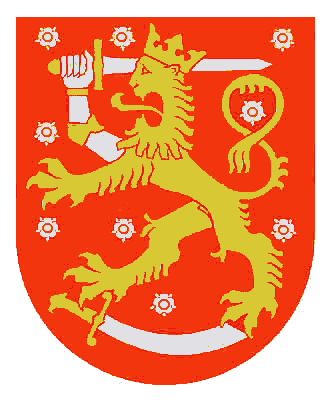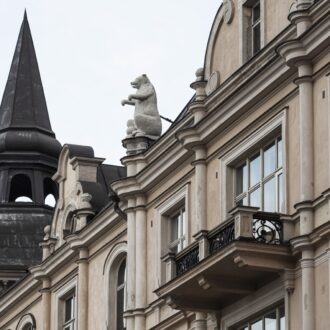The following is a brief description of Finland’s national coat of arms, its symbolism and history. The account is based on the official blazon and the most widely approved explanation.
National Coat of Arms

When King Gustav I of Sweden (died 1560) gave his son John the title of duke of Finland in 1556, the territory also received its own coat of arms, which was probably approved by the king in 1557, although as far as we know Duke John never used it. In addition to national emblems, this coat of arms (Figure 1) included two other symbols referring to northern and southern Finland, in actual fact the areas of Satakunta and Varsinais Suomi (Finland Proper). These two symbols were later retained in the arms of these two provinces.
After ascending the Swedish throne, King John III adopted the title of “Grand Duke of Finland and Karelia” in the year 1581. It was probably at this time or a little later that Finland received a second coat of arms, which is somewhat like the present one. This coat of arms is generally thought to have been modelled on a shield sculpted for the tombstone of King Gustav I at the Uppsala Cathedral (completed 1591). This monument was designed during the reign of John’s elder brother, Erik XIV, who was king from 1560 to 1568, but it was only completed some thirty years later during John’s reign. The shield was probably designed by the Dutch artist Willem Boyen, who served under both Gustav I and Erik XIV.
There is no way to know whether Finland’s second coat of arms was purely the product of Willem Boyen’s own imagination or whether it was based on Erik XIV’s wishes or some other unknown historical tradition. It is known, however, that Erik XIV was himself interested in heraldry. This matter has been the subject of considerable academic debate among scholars and laymen.
At any rate, the general consensus has been that the symbol of the lion is derived from the arms of the Folkung family, which are included in the royal arms of Sweden. The two swords were borrowed from the Karelian coat of arms, which was publicly displayed for the first known time on a banner at the funeral of King Gustav I in 1560.
The placing of the curved Russian sabre beneath the lion’s paws is undoubtedly a reflection of the political situation at this time. Sweden and Russia were almost constantly at war, and the Swedes made use of this propaganda device to imply that they had the upper hand over their enemies. The nine roses are decorative, although they have falsely been interpreted as referring to Finland’s nine historical provinces. It is worth noting that the number of roses has varied over the centuries.
When Finland gained independence in 1917, the “lions arms” became the coat of arms of the new nation. Before this it had served as the common symbol for all the Swedish territory to the east of the Gulf of Bothnia; and from 1809 to 1917 it served as the coat of arms for the Grand Duchy of Finland, which was under Russian rule during this period.
The Finnish coat of arms appears on the state flag, official seals, coins, banknotes and postage stamps. On the President’s car it takes the place of an ordinary registration plate.
It was not until 1978 that legislation was passed concerning Finland’s coat of arms. This legislation gives the official blazon and prohibits the sale of the national coat of arms, subject to fine.
The national coat of arms displays a crowned lion standing on a red field. The lion holds a raised sword in its right gauntleted fore leg and is trampling a curved sabre. The lion, the crown and the sword and sabre handles are gold, as are the gauntlet joints. The blades and the gauntlet are silver. The field is adorned by nine silver roses.
By Maunu Harmo, former president of Finnish Society of Heraldry, last updated March 2011



